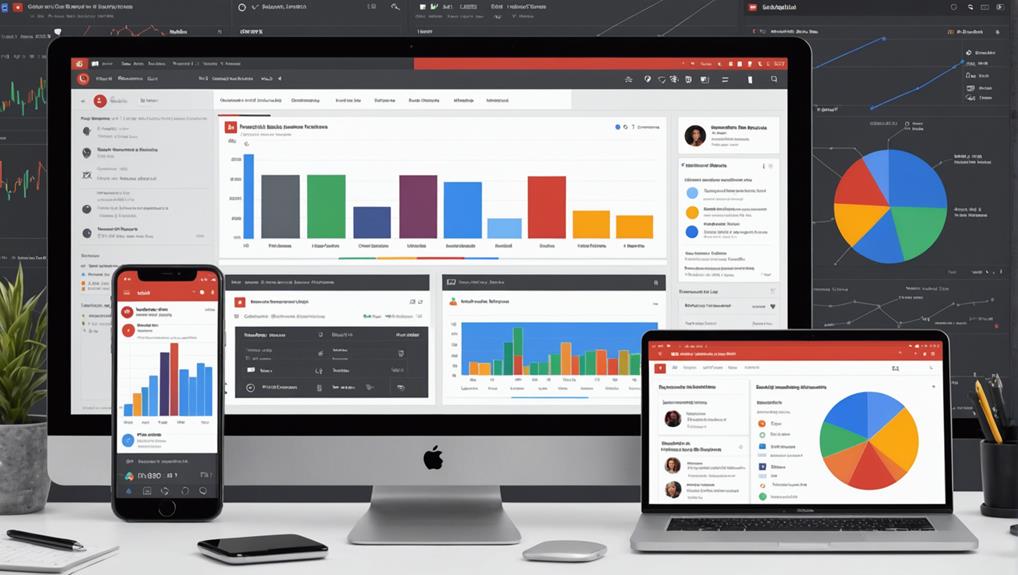To set and measure goals with YouTube Analytics, start by defining your marketing objectives, such as improving brand visibility or increasing engagement. Set specific goals like boosting watch time by 20% or gaining 100 new subscribers monthly. Regularly use YouTube Analytics to track key metrics such as views, watch time, and audience engagement. Analyze these insights to adjust your content strategy and optimize for better results. Use tools like TubeBuddy or vidIQ for deeper analysis. Looking into these strategies can greatly enhance your YouTube channel's performance and growth.
Key Takeaways
- Define SMART goals like increasing watch time by 20% or gaining 100 subscribers monthly.
- Use YouTube Analytics to monitor views, watch time, and engagement metrics.
- Track specific metrics such as click-through rates and average view duration for detailed insights.
- Regularly review audience demographics and behavior to refine content strategy.
- Utilize tools like TubeBuddy or vidIQ for deeper analytics and goal tracking.
Define Your Marketing Objectives
To effectively set and measure goals using YouTube Analytics, you first need to define clear marketing objectives based on brand awareness, engagement, and sales targets. Start by identifying what you want to achieve with your YouTube channel. Are you looking to increase brand visibility and market reach, or is your focus on boosting audience engagement and conversion rates?
To enhance brand visibility, focus on metrics like video views and subscriber growth. These indicators will help you gauge how well your content is reaching new viewers and retaining existing ones. High view counts and a growing subscriber base suggest successful market penetration.
For audience engagement, pay close attention to average view duration, watch time, likes, comments, and shares. These metrics reveal how compelling your content is and how effectively it retains viewer interest. High engagement rates typically translate to more loyal and invested subscribers.
Lastly, to track sales targets, examine conversion rates linked to your videos. Use YouTube Analytics to see how often viewers take desired actions, such as clicking on links or making purchases. By aligning these metrics with your marketing goals, you can monitor performance and make data-driven decisions to refine your strategy.
Set Specific YouTube Goals
Start by defining clear objectives like boosting watch time by 20% or gaining 100 new subscribers within a month.
Identify target metrics such as achieving 10,000 views on a video or a 5% click-through rate.
Use YouTube Analytics to track these goals and make informed adjustments to your strategy.
Define Clear Objectives
Defining clear objectives for your YouTube channel is crucial for sharpening your content strategy and driving measurable success. When you set specific YouTube goals, you enhance your ability to conduct strategy evaluation and guarantee that your content aligns with your overarching objectives. This clarity is pivotal for performance measurement and making data-driven decisions.
Here's how you can define clear objectives:
- Increase Subscribers: Set a specific number of subscribers you aim to gain within a certain timeframe. For instance, target 1,000 new subscribers in the next three months.
- Boost Watch Time: Target a specific increase in watch time, such as an additional 500 hours per month.
- Enhance Engagement: Focus on increasing likes, comments, and shares. For example, aim to increase engagement rates by 20%.
- Improve Video Views: Set a goal for the number of views per video. For instance, aim to achieve 10,000 views on each new upload.
- Optimize Content Reach: Aim to expand your audience by targeting specific demographics or regions, enhancing your channel's overall reach.
Identify Target Metrics
Once you've defined your clear objectives, identifying target metrics like watch time, views, click-through rate, and subscriber growth will help you set specific and actionable YouTube goals. These metrics align closely with your marketing objectives and allow you to track performance effectively.
For instance, higher watch time and views indicate that your content resonates well with your audience. A high click-through rate signals that your video thumbnails and titles are compelling enough to attract clicks.
To set SMART goals (Specific, Measurable, Achievable, Relevant, Time-bound), start by leveraging YouTube Analytics. Regularly review engagement rates to understand how well your audience interacts with your content. High engagement rates often correlate with increased viewer loyalty and can drive subscriber growth.
Additionally, analyze audience demographics to tailor your content better and make sure you're reaching your target market.
Monitor these metrics consistently to measure your progress and adjust strategies as needed. For example, if your click-through rate is below expectations, consider revising your thumbnails or titles.
Access YouTube Analytics
Accessing YouTube Analytics through YouTube Studio provides you with a wealth of data on your channel's performance, including views, watch time, engagement, audience demographics, and revenue. You can access YouTube Analytics on both desktop and mobile, making it convenient to stay updated on your channel's performance on the go.
By using the Search Bar within YouTube Analytics, you can quickly find specific video data, aiding your data interpretation and performance tracking efforts.
To get started, navigate to YouTube Studio and click on 'Analytics' from the left-hand menu. Here, you'll find detailed insights on your channel and video performance. You can explore both Basic and Advanced modes to dive deeper into the data, depending on your analysis needs.
Here's what you can do with YouTube Analytics:
- Views and Watch Time: Monitor overall views and watch time for your channel and individual videos.
- Engagement Metrics: Analyze likes, comments, shares, and other engagement metrics.
- Audience Demographics: Understand your audience's age, gender, and location.
- Revenue Insights: Check your estimated revenue and monetization performance.
- Search Bar: Utilize this for finding specific video data quickly.
Utilizing these features allows you to thoroughly interpret data and efficiently track your channel's performance, setting the stage for strategic goal setting.
Identify Key Metrics
To set effective goals for your YouTube channel, start by identifying key metrics like views, watch time, and subscriber growth that align with your marketing objectives. These metrics provide a foundation for understanding how your content performs and where improvements are needed.
Utilize metrics comparison to see how individual videos stack up against each other, revealing which types of content resonate most with your audience.
Engagement rates, such as likes, comments, and shares, are vital for content optimization. High engagement rates indicate that viewers are actively interacting with your content, which can boost your video's ranking in YouTube's algorithm.
Conduct a target audience analysis to understand who's watching your videos, their demographics, and viewing behaviors. This insight helps tailor content to better meet your audience's preferences, driving higher engagement and retention.
Don't overlook average view duration and click-through rate, as these metrics can indicate the effectiveness of your video thumbnails and titles. A high average view duration suggests compelling content, while a strong click-through rate means your thumbnails and titles are attracting viewers.
Track Performance Regularly
To guarantee that your YouTube channel meets its goals, you must monitor key metrics like views, watch time, and engagement at regular intervals.
Analyzing viewer behavior provides actionable insights that can directly influence your content strategy.
Monitor Key Metrics
Consistently monitoring key metrics like views, watch time, and engagement is essential for accurately tracking your YouTube channel's performance and making data-driven decisions. Keeping a close eye on these metrics enables you to understand engagement rates and viewership trends, which are vital for content optimization.
To effectively monitor your channel's performance, focus on the following key metrics:
- Views: Track the number of views each video gets to gauge its reach.
- Watch Time: Measure the total time viewers spend watching your content to understand overall audience interest.
- Engagement Rates: Analyze likes, comments, and shares to determine how interactive and engaging your videos are.
- Audience Retention: Look at how well your videos keep viewers' attention throughout their duration.
- Subscriber Growth: Monitor how quickly your subscriber base is expanding, which reflects long-term viewer loyalty.
Utilize YouTube Analytics to set benchmarks for each metric, allowing you to measure progress and make informed decisions.
Analyze Viewer Behavior
Regularly tracking viewer behavior through YouTube Analytics gives you insightful data on watch time, views, and engagement, which helps in understanding your audience's preferences.
By focusing on retention rates and engagement metrics, you can gauge how well your content is resonating with viewers. Monitor key performance indicators like average view duration and click-through rates to identify which videos keep your audience engaged the longest.
Consistent analysis of these metrics allows you to recognize patterns in viewer behavior. For instance, a high retention rate on specific videos can indicate that certain topics or presentation styles are particularly effective. On the other hand, low engagement metrics might signal a need for content optimization. This data-driven approach helps you refine your content to better align with audience preferences.
Tracking viewer behavior over time also enables you to identify trends and make informed decisions. By understanding which videos perform best and why, you can focus your efforts on creating similar content, thereby improving your overall channel performance.
Regular performance tracking not only aids in immediate content optimization but also contributes to long-term growth and goal achievement on YouTube.
Adjust Strategies Accordingly
Frequent performance tracking with YouTube Analytics empowers you to make timely adjustments to your content strategies, guaranteeing they remain relevant and effective.
By regularly monitoring key metrics such as views, watch time, and engagement indicators, you can gain valuable insights into your channel's performance trends. This data-driven approach allows you to evaluate your strategy and make data-informed decisions.
To optimize performance and maintain content relevance, it's vital to:
- Track views and watch time: Understanding which videos are attracting viewers and keeping them engaged helps tailor future content.
- Monitor engagement metrics: Likes, comments, and shares indicate how your audience interacts with your content.
- Analyze subscriber growth: Consistent tracking of subscriber growth and retention rates provides a clear picture of your channel's success.
- Evaluate content performance: Assess which types of content perform best and adjust your strategy accordingly.
- Utilize real-time data: Make swift adjustments based on the latest analytics to stay ahead of trends and maintain audience interest.
Consistently leveraging YouTube Analytics for ongoing strategy evaluation and data analysis leads to continuous improvement and performance optimization. This guarantees your content remains effective, engaging, and relevant to your audience, ultimately driving your channel's success.
Analyze Data Insights
Explore YouTube Analytics to monitor key metrics like views, watch time, and engagement, which are essential for measuring your channel's performance. Analyzing these metrics helps you understand audience engagement, enabling you to optimize your content effectively. Delve into the data to see which videos have the highest watch times and engagement rates. This insight tells you what type of content resonates most with your audience, guiding your future content creation.
Understanding audience demographics and behaviors is important. YouTube Analytics provides detailed information on your viewers' age, gender, and geographic location. Use this data to tailor your content, making it more appealing to your target audience. Analyze trends in your metrics to identify what drives subscriber growth and engagement. Recognize patterns like peak viewing times and the types of content that generate the most interaction.
Adjust Your Strategy
Analyzing YouTube Analytics data can pinpoint exactly where your content strategy needs adjustments to boost performance. By interpreting your analytics, you'll understand which aspects of your content resonate with your audience and which don't. Strategy alignment is essential for improving audience engagement and ensuring your content is performing at its best.
Here's how you can adjust your strategy:
- Experiment with Different Formats: Try various video formats and lengths to see what your audience prefers. Data interpretation will guide you in understanding these preferences.
- Optimize Content Based on Trends: Identify trends in audience behavior and engagement metrics. Content optimization involves tweaking your videos to align with what's currently popular or engaging.
- Collaborate with Influencers: Partner with other creators or influencers to explore new content ideas and reach a broader audience.
- Leverage Social Media: Use social media promotions and cross-platform strategies to enhance video performance and engagement.
- Analyze Audience Feedback: Pay attention to comments, likes, and shares. This feedback is invaluable for content optimization and strategy alignment.
Optimize for Success
After adjusting your strategy based on YouTube Analytics, it's time to define specific, measurable goals to optimize for success. Start by setting clear objectives, like increasing watch time by 20% in the next quarter. This goal achievement requires a focused approach, and leveraging YouTube Analytics is essential for tracking your progress.
You should monitor key metrics such as average view duration and subscriber growth. These indicators will help you measure success and determine if your content strategy aligns with your objectives. Regularly analyzing these metrics guarantees that you stay on track and can make necessary adjustments.
To enhance your analytics optimization, consider using tools like TubeBuddy or vidIQ. These platforms provide detailed analysis and goal-tracking features that can offer deeper insights into your channel's performance. By utilizing these tools, you can refine your content strategy based on thorough data, leading to better goal achievement.
Frequently Asked Questions
How to Set Goals for a Youtube Channel?
To set goals for your YouTube channel, define your content strategy and focus on growth metrics. Guarantee your goals are SMART: specific, measurable, achievable, relevant, and time-bound. Regularly review them using YouTube Analytics for adjustments.
How to Measure Youtube Analytics?
To measure YouTube Analytics, you'll track video metrics like views, watch time, and engagement. Analyze traffic sources to understand where viewers come from. Use these insights to make data-driven decisions and optimize your channel's performance.
How to Measure Youtube Success?
Measure YouTube success by monitoring metrics like views, watch time, and subscriber growth. Adjust your content strategy based on analytics, and explore collaboration opportunities to boost engagement and optimize your channel's performance.
How to Measure Audience Engagement on Youtube?
To measure audience engagement on YouTube, focus on engagement metrics like watch time, average view duration, and viewer retention. Track likes, dislikes, comments, and shares to analyze interaction and feedback, ensuring a data-driven approach.
Conclusion
By consistently tracking key metrics through YouTube Analytics, you can accurately measure your progress towards specific goals. This data-driven approach allows you to gain insightful perspectives into viewer behavior, helping you refine your content strategy.
Regularly analyze performance data to make informed adjustments, ensuring that your channel stays aligned with your marketing objectives. Optimization is an ongoing process, and leveraging analytics effectively will drive your YouTube success.
Stay proactive, analyze trends, and adapt for continuous growth.




